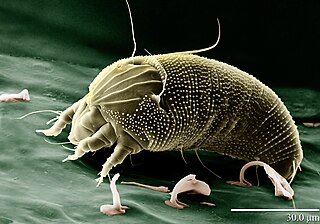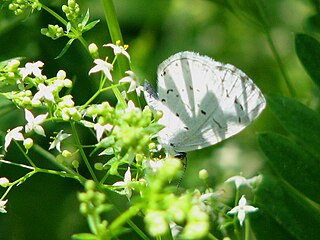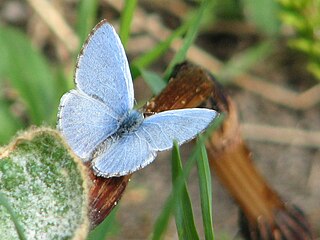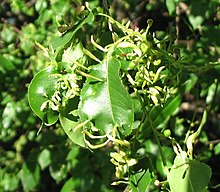
Eriophyidae is a family of more than 200 genera of mites, which live as plant parasites, commonly causing galls or other damage to the plant tissues and hence known as gall mites. About 3,600 species have been described, but this is probably less than 10% of the actual number existing in this poorly researched family. They are microscopic mites and are yellow to pinkish white to purplish in color. The mites are worm like, and have only two pairs of legs. Their primary method of population spread is by wind. They affect a wide range of plants, and several are major pest species causing substantial economic damage to crops. Some species, however, are used as biological agents to control weeds and invasive plant species.

Feniseca tarquinius, the harvester, is a butterfly of the family Lycaenidae, and the only member of the monotypic genus Feniseca. It is found in eastern North America.

Aceria is a genus of mites belonging to the family Eriophyidae, the gall mites. These tiny animals are parasites of plants. Several species can cause blistering and galls, including erineum galls. A few are economically significant pests, while others are useful as agents of biological pest control of invasive plants such as rush skeletonweed, creeping thistle, and field bindweed.

Celastrina ladon, the spring azure or echo blue, is a butterfly of the family Lycaenidae. It is found in North America from Alaska and Canada south of the tundra, through most of the United States except the Texas coast, southern plain and peninsula Florida; south in the mountains to Colombia, also on Molokai island, Hawaii.

Celastrina neglecta, the summer azure, is a butterfly of the family Lycaenidae. It is found in North America. Layberry, Hall, and Lafontaine, in The Butterflies of Canada, describe the species:
The upper surface is pale blue with an extensive dusting of white scales, especially on the hindwing. In some females the blue is almost entirely replaced by white with a small amount of blue near the wing bases. Females have a broad blackish-grey band on the outer third and costa of the forewing. The underside is chalky white to pale grey with tiny dark grey spots and a zigzagged submarginal line on the hindwing.

Eriophyes tiliae is a mite that forms the lime nail gall or bugle gall. It develops in a chemically induced gall; an erect, oblique or curved distortion rising up from the upper surface of the leaves of the lime (linden) trees, such as the large-leaved lime tree Tilia platyphyllos, the common lime tree Tilia × europaea, etc.
Eriophyes padi is a gall-forming mite that causes cherry pouch galls on black cherry trees. Eriophyes padi belongs to the genus Eriophyes and the family Eriophyidae. It lives in Europe and Russia

Celastrina serotina, the cherry gall azure, is a butterfly of the family Lycaenidae. It is found across North America as far north as the treeline. Its flight time is between mid-May and mid-June in eastern Ontario after the spring azure and before the summer azure. The larva has been reported to feed on galls of eriophyid mites and apparently also on the mites themselves, making them one of the rare species of carnivorous Lepidoptera. It is commonly found around woodland roads of upland mixed deciduous hardwood forests which are surrounded by wetlands.

Aceria anthocoptes, also known as the russet mite, rust mite, thistle mite or the Canada thistle mite, is a species of mite that belongs to the family Eriophyidae. It was first described by Alfred Nalepa in 1892.

Acalitus is a genus of mites in the family Eriophyidae. These cosmopolitan, microscopic arthropods form galls on various plants, and some species such as Acalitus essigi and Acalitus vaccinii are pests of agricultural significance associated with berry crops. This genus includes the following species:

Celastrina lucia, the lucia azure, northern azure, eastern spring azure or northern spring azure, is a species of butterfly of the family Lycaenidae. It is found eastern North America, ranging from the Maritimes south through the Appalachian Mountains to West Virginia.

Phyllocoptes eupadi is a mite that chemically induces a pouch gall to develop as a sub-spherical distortion rising up from the upper surface of the lamina of leaves of blackthorn shrubs Prunus padus, Prunus spinosa and other Prunus species. Synonyms are Phytoptus padi Nalepa, 1890 and "Eriophyes padi ", non Eriophyes padi Domes, 2000.

Eriophyes vitis, also known as grape erineum mite or blister mite, is a mite species in the genus Eriophyes infecting grape leaves. E. vitis has spread worldwide and has three distinct strains: a leaf-curling strain, a blister-causing strain, and a strain that stunts the growth of buds. It is a vector of grapevine pinot gris virus and grapevine inner necrosis virus.

Acalitus brevitarsus is an eriophyid mite which induces domed, blister like swellings, known as galls, on some species of alder.

Eriophyes laevis is a gall mite which makes small, pimple-like galls on the leaves of alder. The mite was first described by the Austrian zoologist, Alfred Nalepa in 1889 and is found in Europe and North America.
Acalitus plicans is an eriophyid mite which causes galls on beech. It is found in Europe and was first described by the Austrian zoologist Alfred Nalepa in 1917.
Acalitus stenaspis is an eriophyid mite which causes galls on beech. It is found in Europe and was first described by the Austrian zoologist Alfred Nalepa in 1891.
Acalitus calycophthirus is an eriophyid mite which causes big bud galls on birch twigs. It is found in Europe and was first described by the Austrian zoologist, Alfred Nalepa in 1891.
Vasates aceriscrumena, the maple spindle-gall mite, is an eriophyid mite in the genus Vasates, which causes fusiform galls on the upper surfaces of the leaves of certain maple species in the eastern United States.

Aceria baccharices, also known as the mulefat leaf-blister mite and formerly known as Eriophyes baccharices, is a species of arachnid native to North America that induces galls on two California willows, Baccharis salicifolia and Baccharis glutinosa. This mite was first described to science by Hartford H. Keifer in 1945. According to Keifer, "the type host is the long-leaf type Baccharis which is common to dry washes in northern California. The other host is the same sort of thing but confined to the south." These galls, which look like warty protrusions from the surface of the leaf, are nurseries for the next generation of mites. The adults eventually leave the leaf via anterior exit holes that may be visible.
















